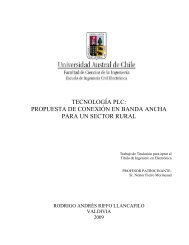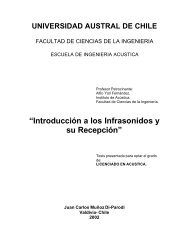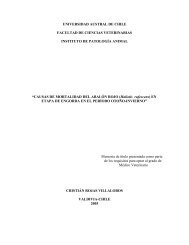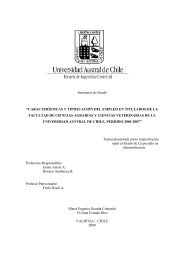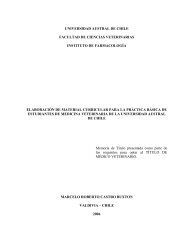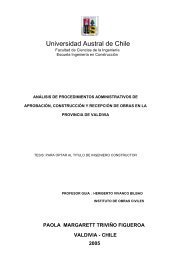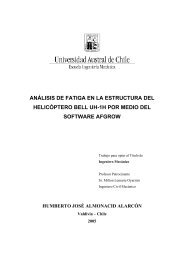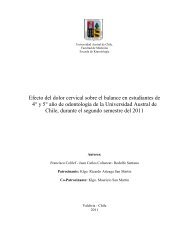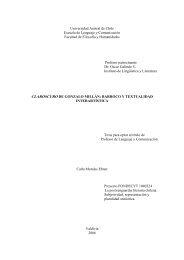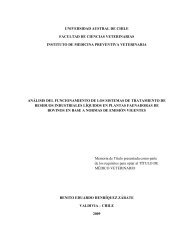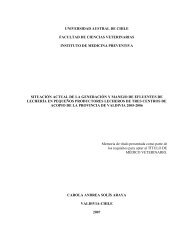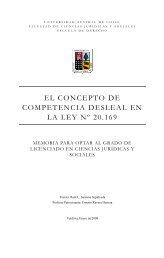Diversidad y control biológico de insectos - CyberTesis UACh ...
Diversidad y control biológico de insectos - CyberTesis UACh ...
Diversidad y control biológico de insectos - CyberTesis UACh ...
Create successful ePaper yourself
Turn your PDF publications into a flip-book with our unique Google optimized e-Paper software.
ecruitment or <strong>de</strong>pletion of prey can not be rule out as potential explanations. Following the<br />
classification scheme for pestici<strong>de</strong> effects suggested by Hassan (1992), the lambda-<br />
cyhalothrin effects can be consi<strong>de</strong>red mo<strong>de</strong>rately harmful (51-75% of mortality or<br />
reduction on beneficial activity) and persistent (more than 30 days).<br />
The B. bassiana isolate B-931 did not caused any significant adverse effects on studied<br />
taxa, which agreed with several other studies carried out on different B. bassiana strains or<br />
isolates. Predators showed a trend to <strong>de</strong>crease in B. bassiana plots ranging from 19-27%,<br />
<strong>de</strong>pending on which data set was consi<strong>de</strong>red (weighted mean = 22%), but these <strong>de</strong>creases<br />
were not statistically significant in any date. In consequence, following the severity in<strong>de</strong>xes<br />
for non-target effects of biological <strong>control</strong> agents suggested by Lynch and Thomas (2000),<br />
our field results ranked 0 or 1 (less than 5% of mortality induced by infection, with no<br />
recor<strong>de</strong>d significant population consequences). Therefore, the isolate B-931 posed a risk<br />
lower than other B. bassiana isolates used at field, such as B. bassiana ARSEF 2883 (James<br />
et al., 1995) or B. bassiana GHA (Jaronski et al., 1998). Spores were alive in significant<br />
numbers less than one week on foliage and less than 15 days in soil. Therefore, they<br />
<strong>de</strong>gra<strong>de</strong>d very quickly un<strong>de</strong>r field conditions and thus non-target species were exposed only<br />
during a limited period of their life-span. This short exposure period and low dispersal<br />
capability are fundamental to consi<strong>de</strong>r B. bassiana as a safe biological <strong>control</strong> agent and<br />
could explain, at least partially, the lack of <strong>de</strong>leterious effects on non-target species. The<br />
inherent selective properties of B. bassiana could play an important role as an explanatory<br />
mechanism for the lack of adverse effects. In general, each strain has a narrow host range<br />
and infectivity <strong>de</strong>creases in heterologous hosts.<br />
The disturbance caused by lambda-cyhalothrin on predators may pose a threat both<br />
biodiversity and the proper ecosystem functioning, including natural pest <strong>control</strong>. The level<br />
of en<strong>de</strong>mism in Chilean carabids is high (55%), <strong>de</strong>spite of Chilean carabid fauna represents<br />
just the 9% of the South American carabid species (Roig-Juñent and Domínguez, 2001).<br />
Repeated insectici<strong>de</strong> inputs can result in the dominance of a few tolerant species, thereby<br />
changing the predator community in the long term (Lee et al., 2001).<br />
Despite of relatively few information is available on ecological structure and functioning of<br />
Chilean pastures, in recent years gut contents and exclusion experiments (Carrillo,<br />
unpubl.*) have given increasing evi<strong>de</strong>nce of the importance of ground-dwelling predators,<br />
85



